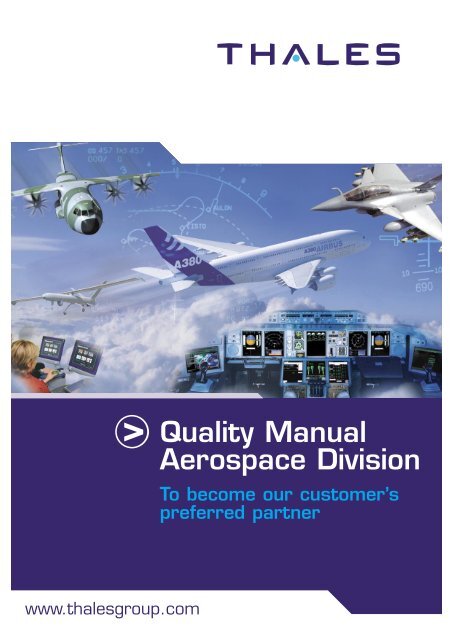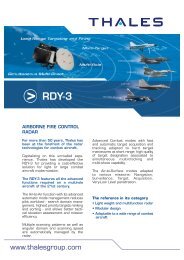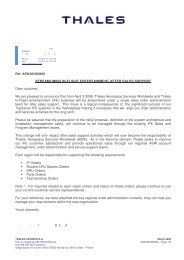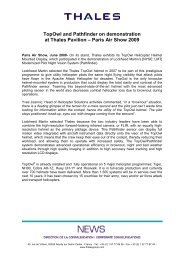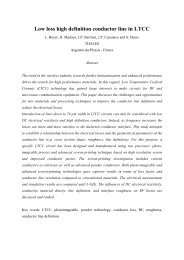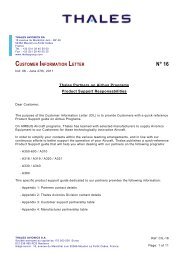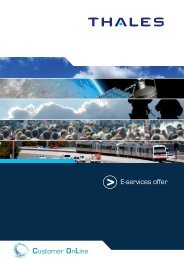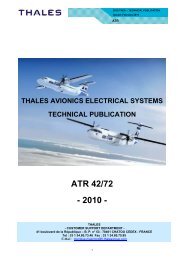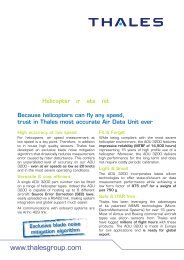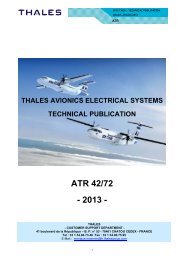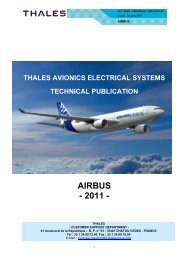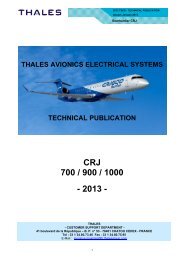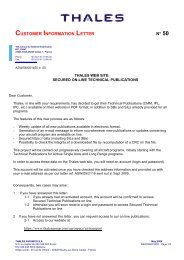Quality Manual - Customer Online - Thales Group
Quality Manual - Customer Online - Thales Group
Quality Manual - Customer Online - Thales Group
- No tags were found...
Create successful ePaper yourself
Turn your PDF publications into a flip-book with our unique Google optimized e-Paper software.
AEROSPACE DIVISIONCONTENTSCore businesses . . . . . . . . . . . . . . . . . . . . . . 4Organisation and facilities . . . . . . . . . . 5Markets and technologies . . . . . . . . . . 6-7<strong>Quality</strong> management system . . . . . . 8Comprehensive securitymanagement system . . . . . . . . . . . . . . . . 9pagesReference System . . . . . . . . . . . . . . . . . . . . 10-11Management principles . . . . . . . . . . . . . 12-13Programme and productquality . . . . . . . . . . . . . . . . . . . . . . . . . . . . . . . . . . . . . 14The <strong>Quality</strong> organisation . . . . . . . . . . . 15Conformity to standards . . . . . . . . . . 16External certifications . . . . . . . . . . . . . . . . 17PurposeThe purpose of this <strong>Quality</strong> manual is topresent the <strong>Thales</strong> <strong>Group</strong> AerospaceDivision, its organisation and <strong>Quality</strong>management system.ScopeThis manual is applicable to the entireDivision, its companies and units.Updating and distributionThis manual is updated each time there isa significant change by the <strong>Quality</strong> andContinuous Improvement Department. It isfreely distributed by that department togovernment entities, customers, companypersonnel and all other interested parties.Christian BernardDirector of <strong>Quality</strong> and ContinuousImprovementFrançois QuentinSenior Vice President,Aerospace Division3
AEROSPACE DIVISION>>CORE BUSINESSESAs a partner on some of the world’sgreatest aerospace successes, the<strong>Thales</strong> <strong>Group</strong>’s Aerospace Divisionsupplies civil and military customerswith a full range of innovative equipment,subsystems, systems andvalue-added services.YEAR 2004REVENUES2,1 billion d’eurosNUMBER OF EMPLOYEES13,000For military platforms, The Divisionsupplies all the critical capabilitiesneeded to achieve air superiorityduring combat, surveillance andintelligence missions.The Division's avionics offering providesall the intelligence needed on boardand on the ground, and performs allthe key flight control, navigation,communication and surveillancefunctions.Its products include cockpit electronics,utilities equipment, and in-flightentertainment systems.The Division's military products fall intofour categories: cockpit electronics,onboard radar, electronic warfare, andmission and UAV systems.In addition, the Division provides innovative,seamless through-life supportservices, as well as on-site and logisticalsupport.In accomplishing all of these missions,the Division draws on a solid platformof technologies, leveraging synergiesbetween civil and military applications.4
AEROSPACE DIVISION>>ORGANISATION AND FACILITIESThe Aerospace Division comprises:• Business Lines (BL), each of which isresponsible for an entire core businessat the international level, and is dividedinto Business Units (BU) at countrylevel.• Technical Business Units (TBU),whose role is to develop a specificarea of technical, technological andindustrial expertise and capabilities.• Central functional departmentsreporting directly to Division management.• Country organisations in countries inwhich the Division has a major presence.Aerospace DivisionSenior Vice PresidentHuman ResourcesResearch, Technology &EngineeringFinance & ControlStrategyAdministration& Legal AffairsCommunicationsGeneral ManagerCountries CoordinationBusiness Lines ManagementOperationsCountriesBusiness LinesTechnical Business UnitsExport Market CoordinationExport Marketing &Sales FranceDefence Domestic MarketingSales FranceDomestic & ExportMarketing / Sales UKBusinessDevelopmentBid and ProposaUnited KingdomACSS (JV)CanadaUSAGermanyDIEHL Avionik Systeme GmbH (JV)Asia / PacificMission AirborneSolutionsISTAR SystemsElectronic CombatSolutionsAerospaceMilitary EquipmentCommercial AircraftSolutionsHelicopter SolutionsAirborne ComputerSolutionsCockpit & Display SystemsElectronic WarfareSolutionsAirborne RadarAvionics & Mission SystemsIn-Flight EntertainmentSupply Chain & ISIndustrialOperationsInformationSystemCentralProcurementOffsetManagementVice President, withinOperations DirectionFranceAvionics ServicesWorldwideInstrumentsProgrammes ControlMilitary <strong>Customer</strong>sServicesNavigation<strong>Quality</strong> & ImprovementProcessesElectrical SystemsDefenceManufacturing Unit FrMicroelectronics / MESLOperationsMicroelectronics / MESLDefence Design& Technology FrComputers Center ofExcellenceComputersOperations UK5
AEROSPACE DIVISION>> MARKETSBusiness LinesThe BLs are the Division’s core management structures and have worldwide responsibility for market segments,products and services. Each BL is made up of Business Units in each country, organised by types ofsystems, equipment and services. The BLs define strategy for one or more countries and organise businessdevelopment efforts. They manage Request For Proposals (RFPs), control investment decisions, define productpolicy and how it is implemented with the customer, and promote synergies.Mission Airborne SolutionsIntegrator and prime contractor for onboard mission systems, the Mission AirborneSolutions (MAS) BL is involved in the development of intelligence and surveillanceaircraft. Its objective is to develop <strong>Thales</strong>’ business in onboard mission systems forcombat aircraft, special-mission aircraft, helicopters and Unmanned AirborneVehicle (UAV) Systems.Microelectronics/MESLThe Microelectronics/MESL BL engineers, manufactures and marketsactive microwave modules, hybrid modules, complex circuitboards, and subassemblies incorporating these elements, as wellas ferrites (power components), in small to medium volumes. Italso designs the associated test benches.ISTAR SystemsDrawing on its experience with the British army’s Watchkeeper UAV programme,Intelligence, Surveillance, Target, Acquisition and Reconnaissance (ISTAR) Systemsaddresses the current and future challenges facing UAV systems. Its other basicrole is to develop network-centric capabilities.Electronic Combat SolutionsThe role of the Electronic Combat Solutions (ECS) BL is to promote and sell radar andelectronic warfare systems and equipment for all naval and air combat platforms.The BL also offers combat aircraft upgrade solutions.Aerospace Military EquipmentAME develops specific military avionic solutions for combat, transport and training aircraft.Commercial Aircraft SolutionsThe Commercial Aircraft Solutions (CAS) BL offers competitive product and systemsolutions for cockpits and passenger cabins (including in-flight entertainment) oncommercial, regional and business aircraft.Helicopter SolutionsLeveraging the Aerospace Division’s experience in both civil and military technologies,Helicopter Solutions acts as prime contractor, systems integrator and supplier of systems,subsystems and equipment for helicopters. Its offering includes user interfaces (helmetmountedLCD and head-up display systems and instruments), navigation, communications,computers, self-protection systems and surveillance radar.Avionics Services WorldwideASW provides an extensive range of services and support for civil avionics and in-flightentertainment (IFE) systems. Services include repair, part replacement, logistics support,ABTH (Avionics By The Hour) and turnkey maintenance contracts. ASW’s main objective isto guarantee customer satisfaction by providing competitive, effective support tailored tothe needs of it diverse customer base.Military <strong>Customer</strong>s ServicesThe role of the Military <strong>Customer</strong> Services (MCS) BL is to ensure the highest possiblelevels of availability of customers' equipment and systems. In addition to developing its“customer services” business, MCS is working to improve its positioning on third-partymaintenance contracts.Electrical SystemsThe Electrical Systems BL designs, develops and manufacturers electrical powergeneration and conversion systems and equipment for aircraft and missiles. Anelectrical conversion system developed by <strong>Thales</strong> has been selected to equip thefuture Boeing 787.ComputersThe Computers BL provides <strong>Thales</strong> with specialised expertise inthe area of signal and data processing, drawing extensively oncommercial technologies to develop its high-performanceproducts.6
AEROSPACE DIVISION>> TECHNOLOGIESTechnical Business UnitsThe role of each TBU is to develop a specific area of technical, technological or industrial expertise, andto deliver competitively priced products within an agreed timeframe and in full compliance with quality specifications.The TBUs are organised on a worldwide basis into product lines and centres of excellence, andcoordinate their work with that of the other <strong>Thales</strong> divisions.Airborne Computer SolutionsACS designs, manufactures and integrates data processingplatforms, mainly for the Commercial Aircraft Solutions,Avionics Services Worldwide, Helicopter Solutions andAvionics for Military Aircraft BLs.Cockpit & Display SystemsCDS designs and manufactures civil and military cockpit equipment and systems.For example, the unit supplies all of the display screens for Airbus cockpits and DassaultAviation combat aircraft.Electronic Warfare SolutionsThe EWS BL supports all the Division’s BLs, developing and manufacturing electronicwarfare systems and equipment for airborne, land, naval and space applications, includingthe SPECTRA and IMEWS systems, as well as self-protection systems for combataircraft, the ASTAC pod, intelligence systems for SIGINT aircraft, and self-defencesystems for the Horizon frigates and other warships.Airborne RadarThe Airborne Radar TBU supports the Division’s BLs by developing, manufacturingand supporting nose radars (RBE2, RBE2 active array antenna, RDY, RC400) forcombat aircraft, as well as airborne surveillance radars (Searchwater and OceanMaster).Avionics & Mission SystemsDrawing on extensive expertise in command and control systems, the Avionics & MissionSystems TBU (AMS) develops, integrates and certifies onboard systems, products andsoftware for the Division’s major civil and military programmes.In-Flight EntertainmentThe In-Flight Entertainment TBU (IFE) designs and manufactures in-flight entertainmentsystems (the TopSeries line) for airline passenger entertainment and telecommunications.It is also developing TopSeries eXecutive, a passenger cabin management system forregional and business aircraft.InstrumentsThe Instruments TBU specialises in flight instrumentation, with product lines includingelectromagnetic and flat-screen instruments with or without integrated sensors,pressure sensors, transmitters, graphical displays and control systems.NavigationThe Navigation TBU develops and manufactures integrated navigation systems, inertialnavigation units, radio navigation receivers (GPS, Egnos, Galileo), air speed indicators,power supply units, navigation computers for civil and military aircraft, helicopters,missiles, UAV systems and launchers, as well as low-voltage power supply systems forthe other TBUs.Operations UKThe Operations UK TBU develops equipment and systems forground-based radar, surveillance radar, naval and airborneelectronic warfare applications, including the Watchkeeperprogramme. It is responsible for supply chain management,system engineering and software engineering.Defence Manufacturing Unit frThe Defence Manufacturing Unit TBU (DMU) is in charge of series production of airborneradars, electronic warfare equipment, onboard military computers and missile electronicsfor proximity fuzes and seekers. Its design office contributes to physical prototype andhardware developments.Defence Design & Technology frThe Defence Design & Technology TBU (DD&T) develops driver/receivers, pointing systemsand power supply units for radars (combat aircraft and maritime patrol aircraft), electronicwarfare receivers and jammers, microwave reception subsystems for missile seekers,mission computers for combat aircraft, and high-power transmitters for surface radars.7
AEROSPACE DIVISION>>QUALITY MANAGEMENT SYSTEMTo achieve its objectives, theAerospace Division has developeda <strong>Quality</strong> ManagementSystem based upon:• Division policy• the Reference System• the <strong>Customer</strong> Commitment continuousimprovement programme.This system is aligned with the <strong>Thales</strong><strong>Group</strong> code of ethics, legal and regulatoryrequirements and is consistent with theDivision’s health, safety and environmentpolicies.Growthandcompetitiveness<strong>Customer</strong>satisfactionPROGRAMMEReferenceQ U A L I T YSystemP O L I C YBuilding awinning teamIn line with <strong>Thales</strong> <strong>Group</strong> core values,the Aerospace Division’s policy hasthree main axes:• Satisfied <strong>Customer</strong>s:Listening to customers and acting ontheir demands with optimum responsiveness,each employee is focused onmeeting the Division's commitmentswith respect to delivery times, quality ofproducts and services, and serviceavailability.• Growth and competitiveness:The Division strives to meet theobjectives set by the <strong>Thales</strong> <strong>Group</strong> bydeveloping its order bookings andworking to increase its competitivenessand capacity for innovation.• Building a winning team:The personal involvement and ongoingprofessional development of eachemployee is key to our success.8
DIVISION AERONAUTIQUE>>COMPREHENSIVE SECURITY MANAGEMENTSYSTEMCompliance with currentlaws and regulationsgoverning health, safety,security and the environment(at the European,national, local, and <strong>Group</strong>levels) is a basic value forthe <strong>Thales</strong> AerospaceDivision.The Division’s health, safety and environmentpolicy is based on the concept ofcomprehensive security for improvedefficiency and effectiveness. This policycovers four basic categories:• Safety and working conditions• Environment• Industrial and defence security• Information system securityThe Aerospace Division is committed tocontinuous improvement in all aspectsof comprehensive security and hasintroduced a risk prevention programmeand defined priority areas of focus forfurther improvement.The Security and Compliance Departmentis charged with implementing this policythrough a directive included in theReference System.The Security Level Evaluation Guide isused to determine the appropriate actionplans. Operational staff incorporate theseaction plans into the budgeting processand provide Division management withregular progress reports.9
AEROSPACE DIVISION>>REFERENCE SYSTEMThe Reference System comprisesthree types of process:• operational processes, co-ordindatedwith project and programme milestones,and conducted to provide customerswith the products, systemsand services that meet their requirements.• management processes, includingall the activities required for managingthe company, its resources andprocesses, and conducted in supportof the operational processes.GovernanceandOrganizationGOVStrategy Target Setting& Major &Investments BudgetingLSS SMI SBP QCIRisksManagement& SecurityMANAGEMENT• expertise processes, making up thetoolbox of methods and tools neededto implement the operational processes.Entreprise ENT Resources RES<strong>Quality</strong> CommunicationResources Estate Systems ingFinance Human Real Information Purchas-& ContinuousImprovementCOMFIN HRM FAC ITS PURManage <strong>Customer</strong> Account (MCA)OPERATIONSBid/No BidDecision to investContract into forceDecision to launchIn service DateSystem EngineeringSYSMethodology and Expertise relevant for each BusinessSoftware Engineering Hardware Engineering Config. Management ManufacturingSWEHWECMTMANCommon & Shared Data BasesLogisticsLOGEXPERTISE10
AEROSPACE DIVISIONThe Reference System consistsof the <strong>Quality</strong> <strong>Manual</strong>, organisationmemos and, for eachprocess:• a description aligned to the <strong>Thales</strong><strong>Group</strong> Reference System, detailingthe purposes of the process, itsplayers and their responsibilities, andthe applicable directives.• procedures, describing activities,sequencing, inputs, outputs, andplayers roles and responsibilities• guides, detailing how to conduct anactivity and the procedures to beused. Certain guides and proceduresrelating to specific areas of expertiseare only applied locally; the others areapplied throughout the Division.• a document defining the managementof the process, measures and tailoringprocedures.ProcessDocumentationow »<strong>Quality</strong>recordsPrinciplesStandardguidelinesDirectivesProceduresFunctional systemQMMOPMOEEnterpriseOrganizationChartUnitOrganizationChartProfession sheetsOrganizational systemAppointmentmemosThe Reference System is managed anddistributed by the <strong>Quality</strong> andContinuous Improvement Departmentand is issued on the company intranet.To ensure efficient management,Document ID Sheets (DIS) are used todefine document management proceduresand assist drafting.The Reference System applies to all theDivision’s projects, programmes andactivities. Best practices developed byoperational staff are systematicallyadded to the Baseline.11
AEROSPACE DIVISION>>MANAGEMENT PRINCIPLESPlan« Strong commitment from Management»The management processes definestrategic objectives and the action plansrequired to meet them. Each managementprocess and operational processis the responsibility of:• an owner, a member of the Division’sManagement Committee in charge ofdefining strategic objectives for theprocess and managing the actionneeded to achieve them• a leader, responsible for deploying andimproving best practice.The <strong>Quality</strong> and Continuous ImprovementDepartment has overall responsibility forprocess management.PLANPAImprovement« <strong>Customer</strong> Commitment Programme »Continuous improvement is an integralpart of the <strong>Thales</strong> <strong>Group</strong> <strong>Customer</strong>Commitment programme, combiningall the actions designed to raise <strong>Group</strong>efficiency in achieving its objectives,particularly customer satisfaction. It isbased on a platform of customer andprocess-related improvement projects,which are managed as programmes(manager, schedule, scorecard) andmonitored by the <strong>Quality</strong> and ContinuousImprovement Department. Outputsfrom these Projects are incorporatedin the Reference System.ACTThis ”top down” approach is complementedby a ”bottom up” approach: theTopLink project encourages all staff tosuggest improvements; the best ideasare rewarded and adopted as bestpractice.12
AEROSPACE DIVISIONDeployment« <strong>Quality</strong>, an everyday reflex »DOManagers, supported by members ofthe <strong>Quality</strong> and Continuous ImprovementDepartment, are responsible for deployingbest practice in their teams. To assistthem, process leaders may definedeployment plans that comprise communication,training and coaching.Process leaders also ensure that bestpractice as implemented is recorded,validated and incorporated in theReference System.The cornerstone of successful deploymentis the everyday involvement of each andevery Division employee.DCLaunchManagement of Improvement ProjectsProjectsheetScopeProjectScopedocumentDashboardDesignin caseofreengineeringPilotsCHECKImplementationClosuresheetMeasure« Non-conformities are opportunitiesfor improvement »Various means are used to detect andmeasure the effective deployment ofReference System practices: surveys,audits and CMMI assessments conductedin-house, by outside bodies and customers,scorecards, checklists, andobservations of best practice in programmes,etc.Based on the results of each metric, ananalysis is made to see whether correctiveaction or improvement is needed and whoshould take charge of implementation(process leader, entity, programme team),or whether a new improvement projectneeds to be added to the <strong>Customer</strong>Commitment programme. Each action isrecorded on a follow-up sheet.13
SR SRRPCAFCAPDRVR SQRCDR TRRArticlesAEROSPACE DIVISION>>PROGRAMME AND PRODUCT QUALITYProgramme and product qualityProgramme life cycle quality assurance is achieved by passing milestone reviewsagreed with the customer, thereby ensuring transparency on programme progress.Programme life cycleIdentify anddevelopopportunitiesBidstrategyClarify andpromotethe offerNegotiationandawardPrepare theexecution ofthe contractDecision tolaunchKick OffmeetingManagement&PlanningLaunchreviewShipping/deliveryreviewsManagementEndingreviewProgrammeendingProgress reviewsRecord of contractual milestoneAcceptanceProduction planningSimilarly, milestone reviews during the product life cycle are opportunities for checking thatactivities have been conducted in conformity with the internal programme baseline andthat the products meet customer specifications as well as legal and regulatory requirements.Product Life CycleOrientationreviewRequirementsreviewDesignreviewPCATRRFCAOR SRR SDR PDR CDRQRQualificationreviewAcceptancereviewOrientationConceptdesignDemonstrationand proof ofconceptDevelopmentAmontProduction anddeploymentOperational Retraitsupport de serviceWithdrawal AmontFunctionalBaselineDevelopmentBaselinePRRProductionreadiness reviewProductionInstallationreviewSR SRRPDRCDRPCAFCAVR SQRTRRArticlesAdjustments to the programme or product life cycles are made at programme kick-offand recorded in the management plan and related plans.14
AEROSPACE DIVISION>>THE QUALITY ORGANISATIONDivision management is responsible forthe proper operation of the <strong>Quality</strong>Management System and continuousimprovement, appointing a Director of<strong>Quality</strong> and Continuous Improvement toensure that the system is implemented.The Director of <strong>Quality</strong> andContinuous Improvement workswith:• the corporate <strong>Quality</strong> department,which is in charge of leading processmanagement, updating the ReferenceSystem, operating the metrics system,particularly external assessments (ISO,civil aviation, CMMI, etc.) and leadingcontinuous improvement• Operational <strong>Quality</strong> departments withinthe Division’s entities.In this way, the quality function is incorporatedin each activity and guarantees thatproducts and services meet customerrequirements.Operational qualityorganisation structureand resourcesAn experienced qualityassurance engineer, workingindependently fromother programme staff,is appointed for eachprogramme.<strong>Quality</strong> AssuranceplanningThe programme qualityplan defines the programme’squality baseline. It isbased on customer requirementsand includes allthe necessary qualityassurance measures.Management of <strong>Quality</strong>Assurance ActivitiesThe programme quality assuranceengineer guarantees thatquality actions are implementedaccording to the quality plan,providing support for the staffin charge and confirming theconformity of the productsdelivered.<strong>Customer</strong>requirementsContractContraintsbudgetscheduleorganisationAdjustementInternalProgrammeBaselineDelegation/tutoringImplementationBaselineJustificationVerification15
AEROSPACE DIVISION>>CONFORMITY TO STANDARDSThe following tables show the correspondence between theReference System and ISO 9001:2000 and ISO 14001.Traceability MatrixSR/ StandardsISO 9001, EN9100, AQAP 2110ManagementENT: EnterpriseGOV: Governance & OrganizationLSS: Risks Management & SecuritySMI: Strategy & Major InvestmentsSBP: Target Setting & BudgetingQCI: <strong>Quality</strong> & Continuous ImprovementCOM : CommunicationRES : ResourcesFIN : FinanceHRM: People ManagementFAC: Real EstateITS: Information SystemsPUR: PurchasingOperational processMCA: Manage <strong>Customer</strong> AccountCAB: Develop & Capture OpportunitiesWIN: Win BidPLP: Plan productMAP: Manage ProgrammeDEV: DevelopSMD: Source Make & DeliverPSS: Provide Services & SupportExpertise processSYS: System EngineeringSWE: Software EngineeringHWE: Hardware EngineeringMAN: ManufacturingCMT: Configuration ManagementLOG: LogisticsSECTIONS OF ISO 90014.1 4.2 5.1 5.2 5.3 5.4 5.5 5.6 6.1 6.2 6.3 6.4 7.1 7.2 7.3 7.4 7.5 7.6 8.1 8.2 8.3 8.4 8.5 4.3 7.7 7.8 9.1 9.2Outside the perimeterOutside the perimeterEN9100Additional elementsAQAP2110Traceability MatrixSR/ Standard ISO 14001ManagementENT: EnterpriseGOV: Governance & OrganizationLSS: Risks Management & SecuritySMI: Strategy & Major InvestmentsSBP: Target Setting & BudgetingQCI: <strong>Quality</strong> & Continuous ImprovementCOM : CommunicationRES: ResourcesFIN: FinanceHRM: People ManagementFAC: Real EstateITS: Information SystemsPUR: PurchasingOperational processMCA: Manage <strong>Customer</strong> AccountCAB: Develop & Capture Opportunities (CAB)WIN: Win BidPLP: Plan productMAP: Manage ProgrammeDEV: DevelopSMD: Source Make & DeliverPSS: Provide Services & SupportExpertise processSYS: System EngineeringSWE: Software EngineeringHWE: Hardware EngineeringMAN: ManufacturingCMT: Configuration ManagementLOG: LogisticsSECTIONS OF ISO 140014.1 4.2 4.3 4.4 4.54.64.3.1 4.3.2 4.3.3 4.3.4 4.4.1 4.4.2 4.4.3 4.4.4 4.4.5 4.4.6 4.4.7 4.5.1 4.5.2 4.5.3 4.5.416
AEROSPACE DIVISION>>To demonstrate to customers theAerospace Division’s ability to meet theirrequirements, we have obtained andmaintain the following external standards:EXTERNAL CERTIFICATIONS<strong>Quality</strong> Management SystemISO 9001for all entities. AQAP 2110for <strong>Thales</strong> Avionics, <strong>Thales</strong> AirborneSystems and <strong>Thales</strong> Electrical Systems.EN 9100 for <strong>Thales</strong> Avionics, <strong>Thales</strong>Canada, <strong>Thales</strong> Electrical Systems,AS 9100 for In-Flight Entertainment.BS EN ISO 9001: 2000 and AS 9100for the Division’s UK sites from LRQAand BSI.Environment Management SystemISO 14001 for <strong>Thales</strong> AirborneSystems, <strong>Thales</strong> Avionics <strong>Thales</strong>Electrical System, <strong>Thales</strong> LiquidCockpit and for the Division’s UK sites.Civil Aviation (production)EASA Part 21 subpart G for <strong>Thales</strong>Avionics, and the Division’s sites in the UK.Civil Aviation (maintenance)EASA Part 145 for <strong>Thales</strong> Avionics andfor <strong>Thales</strong> Electrical System from DGAC,FAR145 for <strong>Thales</strong> Avionics and <strong>Thales</strong>Electrical Systems from FAA, and EASAPart 145 for Division’s UK sites from theCAA.Programme, system engineering anddevelopment management processmaturityCMMI Level 3 targeted for 2006.Aircraft manufacturer approvalAirbus, AgustaWestland, Boeing,Bombardier Aerospace, Dassault Aviation,Eurocopter, British Aerospace, etc.OHSAS 18001 Health and SafetyManagement SystemCertification targeted for 2006.Air freight safety”Recognised freight carrier” approval fromDGAC for <strong>Thales</strong> Systèmes Aéroportés,<strong>Thales</strong> Avionics (CLI, Vendôme sites) and<strong>Thales</strong> Electrical SystemsGlossaireAFAQ : Association Française Assurance QualitéAQAP : Allied <strong>Quality</strong> Assurance Publication (NATO)BSI : British Standards InstituteCAA : Civil Aviation Authority (UK)CDR : Critical Design ReviewCLI : Centre Logistique International (Châtellerault)CMMI : Capability Maturity Model IntegratedDGAC : Direction Générale de l'Aviation CivileEASA : European Aviation Safety AgencyFAA : Federal Aviation Authority (USA)FAR : Federal Aviation RegulationFCA : Functional Configuration AuditGSAC : <strong>Group</strong>ement pour la Sécurité Aviation CivileISO : International Standards OrganizationLRQA : Lloyds Register <strong>Quality</strong> AssuranceOR : Orientation ReviewPCA : Physical Configuration AuditPDR : Preliminary Design ReviewPRR : Production Readiness ReviewQR : Qualification ReviewSDR : System Design ReviewSRR : System Requirements ReviewTRR : Test Readiness Review<strong>Quality</strong> <strong>Manual</strong> Reference:QCI-M-DAE-001-EN/0017
<strong>Thales</strong>Aerospace Division45, rue de Villiers92526 Neuilly-sur-Seine Cedex - FranceTél.: +33 (0)1 57 77 80 00www.thalesgroup.com/aerospacePrinted in France - G00607 - 11/2005 - Photos : Airbus Military - Airbus SAS - Boeing, Dassault Aviation/Aviaplans/F. Robineau - Elbit - Eurocopter/Gérôme Deulin - Stockbyte TM - <strong>Thales</strong>© Tha es 2005 Tha es Systèmes Aéroportés reserves the right to modify the characteristics of this document without notice


